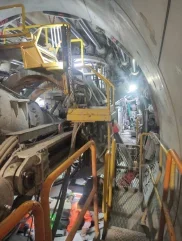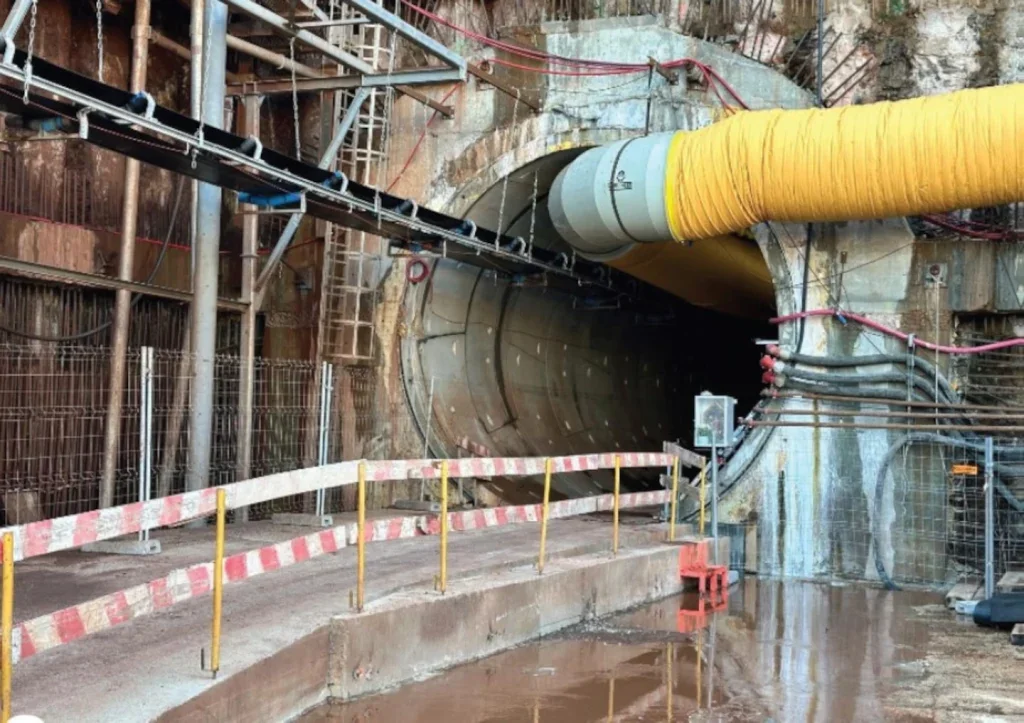
Lisbon has been suffering from intense and more frequent flood events in recent years. These events not only negatively affect the tourism industry but, more importantly, cause long-lasting detrimental effects to the population of the city as well as its property and heritage. Inundation has been experienced in areas such as Baixa and Alcântara.
The Lisbon Drainage Master Plan (LDMP) is intended to minimise the recurring and increasing flooding problem while increasing infrastructure resilience in specific vulnerable areas of the Portuguese capital, including parts of the historical centre.
The activities of the plan have been well underway for some time. They cover infrastructure investment and strategic improvements to the city’s flood management capabilities, aiming to deliver the benefits most notably through large-scale underground works.
By attenuating the size and timing of the peak flood flows, the LDMP is to reduce both the frequency and magnitude of flood events in the city, and minimise potential damage, compared to the current capacities. Key is to store and divert some of the flows so as to delay and reduce the size of the peak flow rates and levels.
Additionally, the LDMP is to also design to deliver substantial environmental quality improvements as well as appreciably enhance the city’s resilience to large flood flows resulting from high-intensity rainfall events.

In total, the strategic drainage improvements over 2016-2030 represent the largest investment ever made by the municipal authority, at Euro 250 million. Almost half of the total budget is funded by loans from the European Investment Bank (EIB).
More than half of the total spend – about 60%, or Euro 150 million – is required for the underground works.
The project (in Portugues is known as Plano Geral de Drenagem Lisboa (PGDL)) is being undertaken by the city council – Camara Municipal de Lisboa
LDMP CONCEPT – FURTHER DETAILS
The origins of the LDMP strategy are from discussions and early proposals starting in 2004, which led two years later to planning works with the consultancy consortium Chiron/ Engidro/ Hidra. A first plan was produced in 2008, considering flood management for one in 10-year rainfall events, but funding problems stalled implantation of the strategy.
Resurrected in 2014, the LDMP was then updated – including to handle one in 100-year rainfall events. The new plan had a focus on the main tunnels plus the basins. A 15-year delivery period to 2030 is planned.

The drainage tunnel concept is not only about flood impact mitigation; the LDMP also includes an internal water recycling distribution system to promote circular economy through water reuse in the city.
Recycled water from the Alcântara Wastewater Treatment Plant is to be distributed throughout the city centre for various activities, such as irrigation of green spaces, street cleaning, and potentially firefighting, thereby saving potable water and reducing costs for citizens.
It is important to notice that the LDMP is an innovative and comprehensive strategy designed to tackle the challenges posed by climate change, particularly the intensification of pluviometric events – with such rainfall events potentially leading to more frequent and severe floods in Lisbon.
The use of innovated technologies and processes, in particular Building Information Modelling (BIM), integrates all relevant project information, facilitating communication among various entities, helping the evolution on the design and also enhancing the construction process’s quality and efficiency. BIM also allows for anticipating and resolving construction issues and preparing for infrastructure maintenance and exploitation, thus adding long-term value to these assets.
The Lisbon Municipality was the first public entity that prepared the tender in order to promote use of BIM, as mandatory for the design phase, as well as the construction and future lifecycle of the infrastructure associated with the LDMP.
This strategic plan, therefore, aligns with the themes of climate change, circular economy, and innovation. Its guiding principle is to develop an integrated flood control solution for Lisbon and provide the city with structural drainage infrastructure prepared for the challenges of the 21st century, while promoting water reuse and efficient use of underground space.
CAPACITY – BASINS AND UNDERGROUND
The main construction activities on LDMP are already ongoing, following initial works on retention basins (in Ameixoeira, Alto da Ajuda, and Parque Eduardo VII), microtunnelling and discharge points (in Parque das Nacoes and Av. Infante D Henrique), and a survey of the drainage network.

Further retention/infiltration basins are planned for several parks and gardens, such as Parque Oeste, Campo Grande, Quinta da Granja, Vale Fundao, and Vale de Chelas.
The focus is the plan is to construct large-scale flow diversion conduits in the form of two main tunnels in different locations: the approximately 5km-long drainage tunnel extending from Monsanto (inland) down to Santa Apolonia (on the coast); and, the approximately 1km-long tunnel from Chelas (inland) down to Beato (coast).
Both tunnels have the same finished diameter of 5.5m and they are being constructed at average depths of 30m-40m below the ground surface, for much of the alignment except for stretches with cover up to about 70m. The alignment is well below building foundations and transport lines, says the council.
Other hydraulic infrastructure in the LDMP design include retention/infiltration basins and also three shafts with vortices that will be linked to pipes leading into the main tunnels.
MAIN TUNNEL WORKS
Following the revitalisation of the project, in 2014, and subsequent approval, in 2015, the procurement process went forward over 2017-18. However, the international open tender process for the design and construction works drew no bids. The process restarted with a call in 2019, award in late 2020, and in early 2021 the city council signed a contract with Mota Engil and Spie Batignolles Internacional. Preparations for the main underground works started in September 2022. Main tunnelling is scheduled to end in 2025.
Construction supervision is by the TPF Consortium, comprising Consultores de Engenharia e Arquitectura S.A and Getinsa Eurostudios, S.L.
Other companies involved are:
- Legal: Miranda & Assoc
- Geotech & hydraulics: LNEC
- BIM: ISCTE
- Hydraulics: Hidra/ Engidro
- Project review: IC-FEUP
- Environment: 4 Rs
This ambitious project faces unique challenges due to the complexity of the urban environment. The tunnel boring machine (TBM), a critical component of the project, is now actively engaged in tunnel excavation, being a significant phase in the project’s progression.
The TBM is actively excavating the tunnel and the overall works are being supported by several construction sites across the city, contributing to overall progress. For instance, the excavation work at the tunnel entry point has been completed and the construction location serves as the main hub to support tunnelling activities, including segment supply and spoil removal.
Additionally, works are ongoing at the tunnel exit areas, particularly for constructing the discharge channels to the Tagus River and connecting vortex shafts for surface flow tunnel discharge in city areas periodically prone to flooding.
TBM boring has been underway for almost a year with a CREG machine, manufactured in China. The first task of the 6.41m-diameter earth pressure balance (EPB) machine (ref CTE6410E-1200) is to construct the Monsanto-Santa Apolonia tunnel.
Monsanto-Santa Apolonia is the longer of the two tunnels and is code referenced as TMSA (Tunel Monsanto-Santa Apolonia). It is being bored from its highest point, inland, at Monsanto with the bore on a 0.84% gradient down to Santa Apolonia. Geology is complex.
Parts of the machine first arrived from China to Portugal in late 2022. The TBM – ‘H2OLisboa’ – was launched at the end of 2023 from the Quinta do Ze Pinta site, in Campolide. It has main drive power of 1200kW. By late May, the TBM had advanced almost 550m.
Shafts along the downhill alignment of the long tunnel are at lower points on the ground surface profile – at Av. Da Liberdade, Largo de Santa Marta, and Av. Almirante Reis. The low points will permit drainage collection into the main tunnel during flood operations.
Excavation of the shorter tunnel (reference code is TCB – Tunel Chelas-Beato) is to be undertaken uphill, from Beato to Chelas. The tunnel is to be bored after the TBM first completes the longer tunnel and then the machine will be transferred to Beato for the next main tunnelling task, expected to get underway in late 2025.
CONCLUSION
The LDMP exemplifies how innovation and technology can address climate change challenges and promote city sustainability and resilience. By constructing efficient drainage infrastructures and promoting water reuse, the plan contributes to transforming Lisbon into a more resilient and sustainable city.






